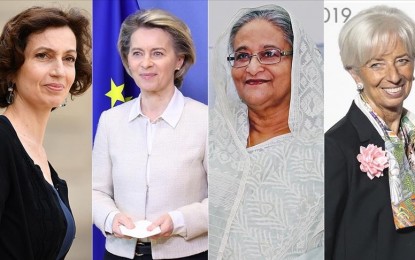
ANKARA – The number of women who perform duties as leaders or high-ranking executives in international organizations has increased over recent years.
A total of 58 countries were governed by a woman between 1960 and 2021, according to data from Germany-based statistics company Statista.
In the last 50 years, 13 countries had more than one female leader.
New Zealand and Finland have had the highest number of women leaders between 1960 and 2021, whereas 199 countries have not had a women leader.
Six female leaders in the world ruled for more than ten years. Bangladesh's Prime Minister Sheikh Hasina Wazed has been the first female leader to remain on duty for the longest period. Ruling with intervals while currently on duty, Hasina has led Bangladesh for nearly 17 years.
Hasina is followed by Indira Gandhi, who served as prime minister in India with intervals. With a ruling period of nearly 16 years, Gandhi has been India's first and only female prime minister.
With a 15-year-long ruling period, German Chancellor Angela Merkel has been among the female leaders who maintained their position for the longest.
Former Prime Minister of Dominica, Eugenia Charles, remained on duty for 15 years, while Ellen Johnson Sirleaf, former president of Liberia, led the country for 12 years, elected consecutively.
Women in executive positions rapidly increased
The number of women who gained leading positions in their countries has rapidly increased over the last 12 years.
Despite this increase, the number of women in leading positions did not exceed 19 in a single year. Thus, female leaders accounted for less than 10 percent of the number of male leaders.
While women run nearly 21 percent of ministries across the globe, the rate of women in cabinets stands over 50 percent in 14 countries, per the report dated Dec. 21, 2020, by the UN Secretariat General.
Besides, women comprised 25 percent of all national parliament members in 2020.
Rwanda had the highest rate of female parliament members with 61 percent, followed by Cuba and Bolivia with 53 percent and the United Arab Emirates with 50 percent.
Women's representation rate in national parliaments was recorded as 9 percent in Europe, 5 percent in Latin America and Caribbeans, 40 percent in an Asia-Pacific country, whereas Pacific island states had the lowest rate of 6 percent.
Women leaders in international organizations has increased
The number of women holding executive positions in international organizations which mostly act under the United Nations has shown a rapid increase in the last four years.
Antonio Guterres, who started his duty as UN General Secretary in Jan. 2017, promised to ensure gender equality among high-rank executives of UN institutions.
The number of women who gained executive positions in the organization has increased with Guterres's special efforts. The rate of women exceeded 50 percent for the first time in 2017 in appointments, per data on high-ranking executives' appointments by the Center on International Cooperation of New York University.
In 2020, 20 women were appointed by UN General Secretariat to high-ranking positions of the organization.
Trade Experettes, which consists of female specialists working in international organizations, indicated that among 291 people brought to high-rank leading positions in the 30 greatest international organizations worldwide, 33 were women.
On the other hand, it pointed out that no woman has been in a high-rank executive position in 14 of these organizations.
African women leading World Trade Organization
Ngozi Okonjo-Iweala, appointed to World Trade Organization General Directorate, has been the first woman and the first African ever brought to the position. Iweala's taking over the leadership was referred to as "a historic moment" by the organization.
Expected to remain on duty until Aug. 31, 2025, Iweala had served as finance minister twice, foreign minister for a short time, and World Bank Operations Executive Director, and the director of Global Vaccine Alliance.
Female manager ruling European Central Bank
French national Christine Lagarde was appointed to the presidency of the European Central Bank on Nov. 1, 2019, becoming the first female president of the bank since it was founded in 1998.
Lagarde had served as finance minister and president of the International Monetary Fund (IMF) before. She was the first female president of IMF as well.
Only 14 of 173 central banks worldwide are led by women, according to research conducted in March 2020 by the Official Monetary and Financial Institutions Forum.
International Monetary Fund
Bulgarian national Kristalina Georgieva was appointed as the president of the IMF on Sept. 25, 2019. Georgieva became the second woman to take over the position after Lagarde.
Georgieva had previously served as the vice-president of the European Commission, responsible for budget and human resources, and CEO of the World Bank.
UNESCO
Audrey Azoulay was appointed as the Director-General of United Nations Educational, Scientific and Cultural Organization (UNESCO) on Nov. 10, 2017.
Azoulay became the second woman to hold the position after Irina Bokova, who served from 2009 to 2017.
As one of the outstanding international organizations of the world, UNESCO has been led by women for nearly 12 years.
European Commission
German national Ursula von der Leyen was appointed as the president of the European Commission on Dec. 1, 2019, becoming the first female president of the council.
Von der Leyen had acted as Germany's defense minister previously.
UNAIDS
Ugandan national Winnie Byanyima was appointed as Executive Director of UN AIDS Agency (UNAIDS) in Aug. 2019, becoming the first woman at the position since the agency's foundation in 1995. (Anadolu)
